- Home
- Peter Ackroyd
Venice Page 5
Venice Read online
Page 5
The twin imperatives of show and spectacle, design and ostentation, move through every level and every aspect of Venetian society. A sixteenth-century account of a bankrupt banker of the Rialto explained in passing that “this market and the city of Venice are naturally very inclined to love and trust in appearances.” The painters of Venice lingered over the rich surfaces of the world. The architecture of Venice had the artifice and outwardness of the theatre. Venetian music has always been concerned with outward effectiveness rather than internal coherence. The literature of Venice was oratorical in nature, whether in theatre or in popular song. No other city-state in Italy was so concerned with problems of rhetoric and style. Venetian ceilings are characteristically false ceilings, suspended somewhere beneath the beams. In the eighteenth century display and spectacle became a way of masking the decay and failure of public policy. It is a constant note, one that provides a clear insight into the identity of the city and its people.
The contemporary restoration of many buildings in Venice is a case history of seeming rather than being. In their devotion to appearances the restorers have created an unreal city, bearing little relation to its past or to its present. The architects and designers were concerned to reprise the aesthetic contours of the city; but these were imagined rather than real, the fruit of wishful thinking and nostalgia. What happened in practice is that they remodelled or modified the architectural language of the past to make it fit their own preconceptions of how Venice really ought to look. Fluting and veneer were removed; horizontal lines were straightened and strengthened; windows were altered to conform to the structure; balconies were narrowed for the sake of overall harmony; attics were taken out, and baroque fixtures replaced by Gothic. For some reason the stronger shades of red and yellow have spread in a city where they did not exist before. The style was known as ripristino. It amounted to the creation of fakes. It is an example of a general malaise of modern Venice, first recognised by the German sociologist Georg Simmel in the early part of the twentieth century. He remarked that the city represented “the tragedy of a surface that has been left by its foundation.” That does not render Venice superficial. Quite the contrary. The attention to surface, without depth, provokes a sense of mystery and of unknowability.
For many centuries Venice has been famous for its glass-making, now the preponderant industry on the island of Murano. What is the attraction of glass for the city of the sea? Glass is material sea. It is sea made solid, its translucence captured and held immobile. It is as if you could take up handfuls of the sea and turn it into brocade. Venice is the place for this. The first writer on the making of glass in Venice, Georgius Agricola, wrote in the early sixteenth century that the glass was formed out of “fusible stones” and “solidified juices,” an apt translation of Venice’s position between water and stone. Sand becomes crystal. It is not Venetian sand, however. It came from Syria and then later from Fontainebleau in France. Yet the Venetian glass-makers were the most ancient, and the most skilled, in the world.
Glass-makers had worked in the lagoon from the time of the Romans. There are finds of glass from the fourth to the seventh centuries, and a seventh- or eighth-century furnace in Torcello shows evidence of Roman manufacturing conditions. Folk tradition always asserted the continuity of glass-making on the islands, and there may indeed have been some legacy of inherited skills. Yet much of the expertise derived from Byzantine and Islamic sources. It is another example of the balance Venice maintained between two worlds.
An individual glass-maker, a certain “Domenico,” is first mentioned in a document of 982. A Venetian guild of glass-makers was established in the thirteenth century. In that same century, for fear of fires, the glass-manufacturers were transferred to the island of Murano. There they flourished. But they were in a sense imprisoned by the state. They could not move to any other part of Italy. To reveal any of the secrets of Venetian glass-making was to incur the death penalty. Any workman who escaped to the mainland was hunted down and, where possible, forcibly retrieved. It is, if nothing else, a token of the importance of the trade in the Venetian economy. Glass-making was vital to the city’s economic success. It would be absurd to suggest that the Muranese workmen believed themselves to be oppressed, or were forced to labour in any climate of fear, but the threat of state punishment is an apt token of the constant presence of the Venetian state in all aspects of Venetian life. It was by no means a free society. It was an insular, and therefore enclosed, society.
They made goblets and ewers, bottles and flasks, beads and chalices, lamps and windows, pitchers and eye-glasses, as well as a range of ornamental objects created out of cristallo, a malleable form with all the translucence and brilliancy of rock crystal. They could render a glass so fine that it was reputed to burst into fragments if it came into contact with poison. The workmen of Murano created glass that had the colour of milk, glass that mimicked the texture of ice, glass threaded with copper crystals. Types of glass resembled marble or metal or porcelain. From the fifteenth century forward, in fact, Venetian glass grew ever more elaborate and ornate. It became a luxury, at a time when Venice had become the provider of luxuries of every description. Objects became ever more useless and ever more expensive. In 1500 one contemporary noted of the Muranese glass industry that “there is no kind of precious stone that cannot be imitated by the industry of the glass-workers, a sweet contest of man and nature.”
Venice had already been involved in that contest, sweet or otherwise, for many hundreds of years. It is another reason for its perfect adaptation to the trade. An early seventeenth-century English traveller, James Howell, marvelled how a furnace fire could “convert such a small lump of dark Dust and Sand into such a precious clear Body as Crystal.” But had not Venice wrought such a transformation upon itself, from the dark dust and sand of its origins? Out of that dust and sand came a crystal city, its churches and bridges and houses billowing out and growing ever more expansive. When the travellers came to Murano, in order to observe all the arts of glass-blowing with spatula and pincer, they were peering into the nature and growth of the translucent city.
The lagoon was often described as resembling molten glass, and indeed glass became a metaphor for Venice itself. There was a saying that “the first handsome woman that ever was made was made of Venetian glass.” Glass is translucent, weightless; it is not a dense material, but is a medium for colour and light. Glass has no content. It is all surface, infolded in crests and waves, where the inner is also outer. Venetian painters learned from their fellow citizens who worked at the furnaces. They learned how to mingle colour, and how to create the impression of flux and molten form. They borrowed material in a literal sense. They mingled tiny pieces of glass with their pigments, to convey the shimmer and transparency they observed all around them. It glimmers; it is flecked by foam; it ripples and undulates; it possesses a giant translucent calm; it has currents of darker colour; it is fluid. So the glass is, like Venice, of the sea.
An early map of Venice, devised in the late fifteenth or early sixteenth centuries; it looks small, fragile and defenceless in its watery world. (photo credit i1.1)
A perspective plan of Venice, painted with oil upon panel, displays the city at its most stately and noble. (photo credit i1.2)
The interior of the basilica of Saint Mark, glowing with the radiance of gold. The roof is a sea of gold. The mosaic work, covering forty thousand square feet, is a skein of iridescence thrown across the walls and arches. (photo credit i1.3)
A mosaic of the Virgin Mary, from the beginning of the thirteenth century, from the basilica of Saint Maria Assunta on the island of Torcello. Mosaic is the true art of Venice. (photo credit i1.4)
A mosaic of the Flood in the western portico of the basilica of Saint Mark. The fear of encroaching waters was a Venetian obsession. (photo credit i1.5)
The Stealing of the Body of Saint Mark, by Tintoretto. Only in Venice can the artist’s fieriness and extravagance be properly realised. His art is Venic
e in its purest and most spiritual form. (photo credit i1.6)
The Lion of Saint Mark, painted on panel in the fifteenth century. It is the image of Venice, seen everywhere in the city. The leonine symbol is one of authority and of paternalism. It is also a token of justice. (photo credit i1.7)
Monks praying to Saint Theodore, an illustration of the fourteenth century. Saint Theodore was the patron saint of Venice before being replaced by Saint Mark. He was a wholly Byzantine saint, emphasizing the city’s early affinity with that civilisation. (photo credit i1.8)
A photograph of the piazzetta San Marco, with the pillars of Saint Mark and Saint Theodore guarding the holy space. The piazzetta was redesigned in the sixteenth century as a stage set, with the pillars as the frame. (photo credit i1.9)
A religious procession in front of the basilica, completed by Gentile Bellini in 1496. Such processions had both a civic and spiritual significance. They were the living embodiment of sacred and secular governance in Venice. (photo credit i1.10)
A photograph, taken in the 1880s, of the crowds in Saint Mark’s Square. The Square became known as “the finest drawing room in Europe.” (photo credit i1.11)
The Miracle of the Cross on San Lorenzo Bridge, painted in 1500 by Gentile Bellini. Venice was itself a city of miracles. No city in Europe, with the possible exception of Rome, has witnessed so many. The survival of Venice itself, on the waters, was deemed to be a miracle. (photo credit i1.12)
The departure of the doge’s ship, the “Bucintoro,” towards the Venice Lido on Ascension Day. This scene, painted by Francesco Guardi in the 1760s, depicts the marriage of the city and the sea. The doge halted at the part of the Lido where the waters of the Adriatic and the lagoon meet. Here a large flask of holy water was emptied into the mingling currents. (photo credit i1.13)
The Healing of a Possessed by Vittore Carpaccio, painted in 1494. Here can clearly be seen the Rialto bridge spanning the Grand Canal. The artist faithfully depicts the wooden bridge, the sign of the Sturgeon Inn, the houses and institutions along both banks of the Canal. His is the poetry of urban detail, with its bricks and balconies and chimney-tops. (photo credit i1.14)
II
The City of Saint Mark
4
The Saint Comes
There was one great transformation in the early history of Venice. In 828 an object was brought to this place that entirely changed its character and its status. It is supposed to have been the body of the great evangelist, Saint Mark himself. The essential story remained unchanged through the centuries. It concerned some Venetian merchants—a class who, from the beginning, took the lead in all the affairs of the Venetian state. Buono of Malamocco and a companion, Rustico of Torcello, had gone on a trading mission to the port of Alexandria. In that alien land they entered into a discussion with the custodians of the church of Saint Mark, who were responsible for protecting the body of the martyred saint lodged in an ancient sarcophagus. These priests bitterly resented the persecution of the Catholic community by the Saracens, and expressed the fear that their precious church might be pillaged and damaged. The Venetians listened with great sympathy, and then suggested to the priests that they might like to return with them to Venice; they might also care to bring the body of Saint Mark with them. That could be considered the price of their journey. It was a piece of business. Despite certain misgivings, the custodians agreed.
The body of Saint Mark was taken out of the sarcophagus and unwrapped from its silk shroud, the relic being substituted by another and less eminent saint. It was then placed in a chest and taken on board the Venetian ship, the merchants first ensuring that the saint’s remains were covered by a layer of pork and cabbage. When the Muslim officials asked to inspect the chest, they cried out “Kanzir, kanzir” (Oh horror) at the sight and smell of the pork. The sainted corpse was first concealed in a sail and suspended from the yardarm but, when the holy cargo had reached open sea, the saint’s body was placed on the deck surrounded by candles and thuribles. Thus the evangelist was safely conveyed to Venice, but not before a number of miracles eased his passage across the Mediterranean.
His arrival could not have been more propitious. By mysterious means Mark informed his guardians that he wished to be taken to the ducal palace rather than to the cathedral church then rising in Olivolo. He was lodged in the banqueting hall, but a chapel dedicated to his memory was erected in an open area where the basilica of Saint Mark’s now stands. It was then a grassy field, planted with trees, as well as a garden and fruit orchard. All this was removed and filled, so that the chapel of Saint Mark might rise.
The devotion to Saint Mark soon outstripped that to the previous saint, Theodore, and the great basilica was eventually raised in his name. The ducal palace needed a shrine to bolster its legitimacy, and it could be suggested that the shrine required a palace; the covenant between them instantly magnified both the status of the doge and the power of the community. If anyone were rash enough to question the account of the divine prize, according to a later Venetian historian, then “let him come to Venice and see the fair church of Monsignor S. Marco, and look in front of this fair church” at the mosaics that faithfully tell the whole story. This may not be evidence that would stand up in a court of law, but it was enough testimony for the pious and the credulous. The mosaics were only the most prominent examples of the cult of Saint Mark. On the great arch, above the right-hand singing-gallery of the basilica, can be found the scene of the embarkation of Mark’s body; there is the ship sailing for Venice; there is the reception of the body in the city. These are mosaics from the end of the twelfth century, made luminous by the decorum and formality of the Byzantine tradition. Mosaics are the filigree upon the silver surface of Venice.
From the beginning, the cult of Saint Mark was as much a secular as a sacred affair. He became the icon and emblem of Venice (together with his winged lion), but he was always associated with the doge rather than the bishop. The open theft of the relic was not an issue. There soon grew up a legend that Mark had been bishop of Aquileia, to the north of the lagoon, before ever becoming bishop of Alexandria. And in any case the fact that the transition had been made with the blessing of Mark himself proved its benefaction. God’s will had been done. Otherwise the theft would not have succeeded. It is one of those circular arguments that are very difficult to break. In the thirteenth century another layer of the story was added. It was claimed that Saint Mark, on one of his missions, sought refuge from a storm and providentially took shelter on the island of Rialto. Here, in the future Venice, an angel appeared to him and proclaimed “Pax tibi, Marce. Hic requiescet corpus tuum.” Be at peace, Mark. Your body will one day rest here. There is of course no historical record of the evangelist ever visiting the lagoon.
There are in any case many problems with the original account, not the least serious being the fanciful chain of events that led to the translatio of Mark. That there was some kind of theft seems clear. That a sacred relic was lodged in Venice is also clear. It may or may not have been the body of Saint Mark himself. It might have been any ancient body, wrapped in pious fraudulence as heavy as any shroud. It is likely that the merchants had in fact been sent to Alexandria by the doge, precisely in order to purchase the relic. Its removal to Venice would heighten the sacred authority of the doge as well as the importance of Venice itself. Venice and Mark might rival Rome and Peter. It is interesting that Mark had been secretary to Peter, and that Peter had quarrelled with Mark for being insubordinate and insufficiently devout; these were precisely the charges raised against Venice by successive popes. From the time of the translatio Venice had a most uneasy relation with Rome, never conceding the primacy of the pontiff in its religious affairs.
Many other consequences flowed from the translatio. The presence of the saint was supposed to guarantee Venice from assault or blockade, and thus lend credence to its claim of invulnerability. Venice did survive, unscathed, until the time of Napoleon. The blessing of the saint would also unify the isl
ands of the lagoon under the leadership of Venice, a political and social transition that did indeed take place over the course of two or three centuries. There were rumours that the head of the evangelist had been left behind at Alexandria, but the Venetian accounts insist upon the wholeness of the body. Insecurity in the spirit demands completeness elsewhere. The wholeness of the relic was also an analogy for the organic interdependence of the islands of the lagoon.
It is important, too, that the saint arrived by sea. The sea had become Venice’s true element, and there was no better way of sanctifying it than by claiming it as the shining path of divine protection. The mosaics in the basilica emphasise the image of the ship upon the waves. In a later legend a trio of saints—Mark, George and Nicholas—commandeer a fishing vessel and quell a storm in the lagoon that has been brewed by demons. On his disembarkation Mark presents a gold ring to the fisherman, who in turn gives it up to the doge. Power over the sea is transferred from saint to fisherman to leader. It is one of the formative myths of Venice, engaged in its continual fight against the waters.
There is also the question of free trade, upon which Venice depended. At the time of Mark’s translatio, the Byzantine emperor had imposed a trade embargo between Christians and Saracens. But in defiance of that prohibition the two merchants had transported their holy cargo from Alexandria, perhaps clearing the way for other less precious commodities. It was a hit against the emperor and a good omen for the merchants. If you cannot farm, as the Venetians used to tell the pope, who also complained about their trade with the infidel, you must fish. And that included fishing for saints. It was said that at the time of the opening of the sarcophagus in Alexandria a delicious odour as of “sweet spices,” filled the city. Venetian traders were well known for their bartering of spices.

 The Clerkenwell Tales
The Clerkenwell Tales The Canterbury Tales
The Canterbury Tales J. M. W. Turner
J. M. W. Turner Chatterton
Chatterton The Canterbury Tales – A Retelling
The Canterbury Tales – A Retelling Alfred Hitchcock
Alfred Hitchcock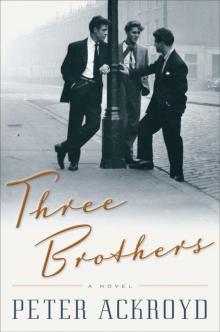 Three Brothers
Three Brothers Wilkie Collins
Wilkie Collins Venice
Venice Poe
Poe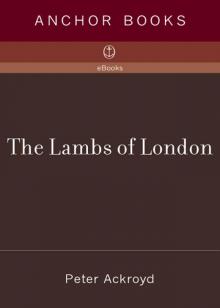 The Lambs of London
The Lambs of London London
London Queer City
Queer City Revolution, a History of England, Volume 4
Revolution, a History of England, Volume 4 Venice: Pure City
Venice: Pure City Foundation
Foundation Thames
Thames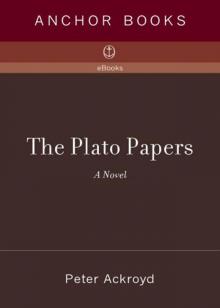 The Plato Papers
The Plato Papers The house of Doctor Dee
The house of Doctor Dee Rebellion: The History of England from James I to the Glorious Revolution
Rebellion: The History of England from James I to the Glorious Revolution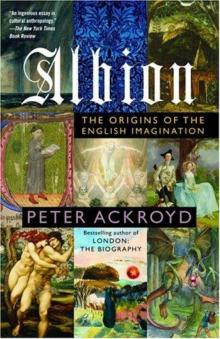 Albion: The Origins of the English Imagination
Albion: The Origins of the English Imagination The Fall of Troy
The Fall of Troy The Death of King Arthur
The Death of King Arthur The Trial of Elizabeth Cree
The Trial of Elizabeth Cree London: The Biography
London: The Biography The Casebook of Victor Frankenstein
The Casebook of Victor Frankenstein Hawksmoor
Hawksmoor Charlie Chaplin
Charlie Chaplin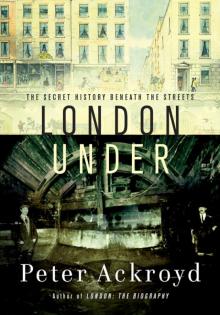 London Under
London Under